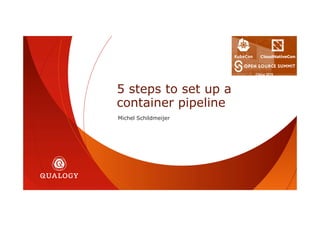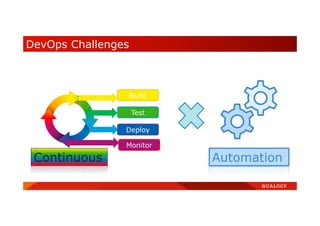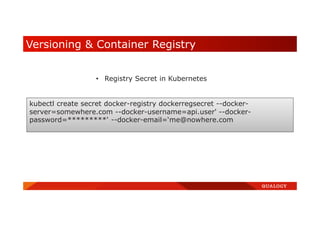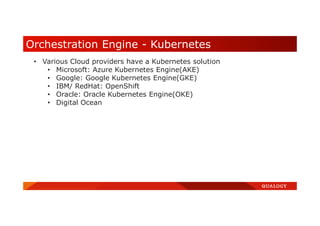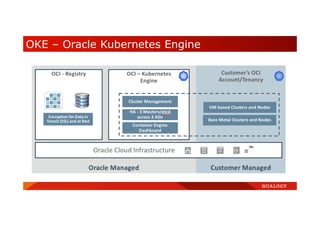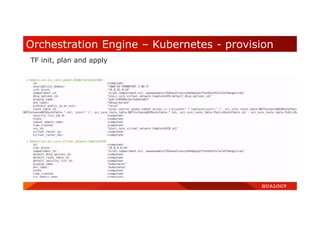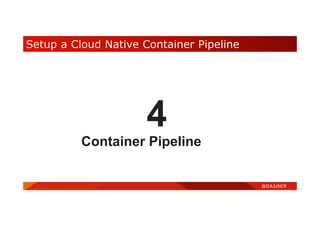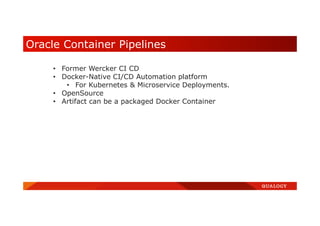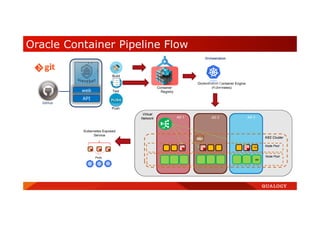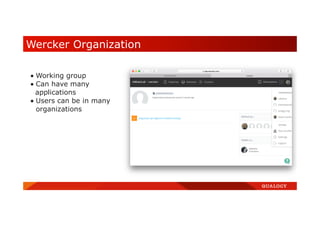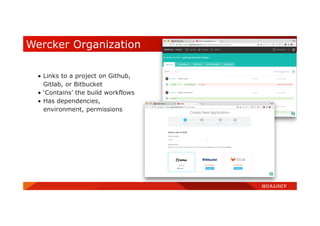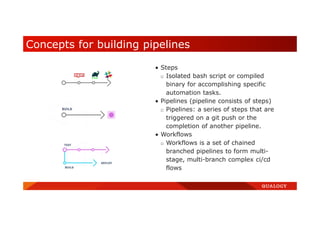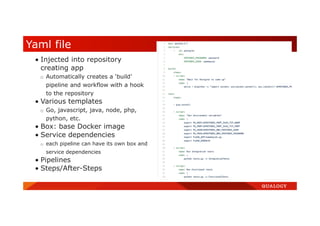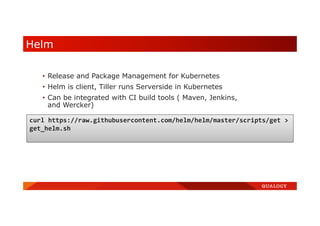5 steps to take setting up a streamlined container pipeline
- 1. Michel Schildmeijer 5 steps to set up a container pipeline
- 2. Me • From Amsterdam, the Netherlands • Lead Technologist at Qualogy • Oracle ACE since 2012 • Authored 2 books about WebLogic in 2011 • Started with UNIX in 1994 • Started with BEA technology in 2000 • Focus on containerization strategies, DevOps etc.
- 4. Investigate increasing error rate Increasing percentage of bugs Lack of continuous visibility in DevOps teams DevOps Challenges
- 5. Ingredients for a Cloud Native Container Pipeline • Versioning & Container Registry • Containers & Orchestration Engine • Provisioning • Container Pipelines • Packaging & Deployments
- 6. Setup a Cloud Native Container Pipeline 1 Versioning & Container Registry
- 7. Versioning & Container Registry • Versioning repo • GitHub for Git • Subversion • BitBucket • Container Registries • Docker • Vendor Registries • Private Registries: • OCIR: • Private,HA
- 8. Versioning & Container Registry • Use of Github authentication for Kubernetes • Use the webhook Module kubectl create -f https://raw.githubusercontent.com/oursky/kubernetes-github- authn/master/manifests/github-authn.yaml • K8S Webhook token authenticator for shareable access • Instruct the apiserver to use the webhook config --authentication-token-webhook-config-file --authentication-token-webhook-cache-ttl
- 9. Versioning & Container Registry • Use of Github authentication for Kubernetes • Use the webhook Module • K8S Webhook token authenticator for shareable access • Deploy keys per projects
- 10. Versioning & Container Registry kubectl create secret docker-registry dockerregsecret --docker- server=somewhere.com --docker-username=api.user' --docker- password=*********' --docker-email=‘[email protected] • Registry Secret in Kubernetes
- 11. Containers & Orchestration Engine 2 Containers & Orchestration Engine
- 12. Orchestration Engine - Kubernetes • Is a Framework for building distributed platforms • Manages & orchestrates container processes (docker) compute networknetwork storage
- 13. Orchestration Engine - Kubernetes • Various Cloud providers have a Kubernetes solution • Microsoft: Azure Kubernetes Engine(AKE) • Google: Google Kubernetes Engine(GKE) • IBM/ RedHat: OpenShift • Oracle: Oracle Kubernetes Engine(OKE) • Digital Ocean
- 14. OKE – Oracle Kubernetes Engine
- 15. Setup a Cloud Native Container Pipeline 3 Provision Kubernetes
- 16. • Scripted setup Kubernetes Engine • Any Cloud Infrastructure (OCI) • Terraform providers client Generate priv/pubkeys Set TF envars terraform plan terraform apply Setup compartment Verify tenancy& user details Setup API key K8S Orchestration Engine – Kubernetes - provision
- 17. Orchestration Engine – Kubernetes - provision TF init, plan and apply
- 18. Setup a Cloud Native Container Pipeline 4 Container Pipeline
- 19. Oracle Container Pipelines • Former Wercker CI CD • Docker-Native CI/CD Automation platform • For Kubernetes & Microservice Deployments. • OpenSource • Artifact can be a packaged Docker Container
- 20. Container Registry AD 1 AD 3 Node Pool K8S Cluster Node Pool BM VM Virtual Network PV AD 2 Kubernetes Exposed Service Orchestration Container Engine (Kubernetes) Pods LB Test Push Build Oracle Container Pipeline Flow GitHub Orchestration web API
- 21. Working group Can have many applications Users can be in many organizations Wercker Organization
- 22. Links to a project on Github, Gitlab, or Bitbucket ‘Contains’ the build workflows Has dependencies, environment, permissions Wercker Organization
- 23. Steps □ Isolated bash script or compiled binary for accomplishing specific automation tasks. Pipelines (pipeline consists of steps) □ Pipelines: a series of steps that are triggered on a git push or the completion of another pipeline. Workflows □ Workflows is a set of chained branched pipelines to form multi- stage, multi-branch complex ci/cd flows Concepts for building pipelines
- 24. • Added to wercker.yaml • Add Pipeline: deploy-to-cluster • Add K8S specifics Oracle Container Pipeline
- 25. Terraform Step - script: name: Set Terraform variables code: | export TF_VAR_my_var1=foo export TF_VAR_my_var2=bar - releasequeue/run- [email protected]: action: "plan" out_file: "output_file" state_stor_bucket: "test- terraform-state-bucket" state_stor_bucket_region: “eu-fran-1" state_stor_key: "terraform_state"
- 26. Steps: install packages, run tests, etc. env variables, SSH keys ‘build’ pipeline created by default ‘Pipelines’ concept is in the web UI and in the wercker.yml file Pipelines
- 27. Injected into repository creating app □ Automatically creates a ‘build’ pipeline and workflow with a hook to the repository Various templates □ Go, javascript, java, node, php, python, etc. Box: base Docker image Service dependencies □ each pipeline can have its own box and service dependencies Pipelines Steps/After-Steps Yaml file
- 28. Flexible linking of pipelines Requires pipelines in wercker.yml and configured in the web UI. □ Depends on yml file, but workflows are not in the yml file Variation based on branch Parallel processing – concurrency Pipeline workflow
- 29. Helm 5 Helm
- 30. Helm • Release and Package Management for Kubernetes • Helm is client, Tiller runs Serverside in Kubernetes • Can be integrated with CI build tools ( Maven, Jenkins, and Wercker) curl https://raw.githubusercontent.com/helm/helm/master/scripts/get > get_helm.sh
- 31. Helm helm init $HELM_HOME has been configured at /home/oracle/.helm. Tiller (the Helm server-side component) has been installed into your Kubernetes Cluster. Please note: by default, Tiller is deployed with an insecure 'allow unauthenticated users' policy. To prevent this, run `helm init` with the --tiller-tls-verify flag. For more information on securing your installation see: https://docs.helm.sh/using_helm/#securing-your-helm-installation Happy Helming!
- 32. Helm kubectl create serviceaccount --namespace kube-system tiller serviceaccount "tiller" created kubectl create clusterrolebinding tiller-cluster-rule --clusterrole=cluster-admin -- serviceaccount=kube-system:tiller clusterrolebinding "tiller-cluster-rule" created kubectl patch deploy --namespace kube-system tiller-deploy -p '{"spec":{"template":{"spec":{"serviceAccount":"tiller"}}}}' deployment "tiller-deploy" patched
- 33. Helm Basic Components .helm/ charts/ templates/ Chart.yaml values.yaml Basic info about name, description, version of app Templates for charts; tiller parses them with values Values for parsing templates to tiller
- 34. Helm workflow architecture Helm ChartHelm Chart tiller server K8s api-server Chart deployed Application
- 35. Add these all to wercker pipeline Setup the git repository Add application wercker_helm- chart-generate Don’t generate wercker.yml Set the proper variables Run the build
- 36. Add these all to wercker pipeline Setup the git repository Add application wercker_helm- chart-generate Don’t generate wercker.yml Set the proper variables Run the build
- 37. Add these all to wercker pipeline Setup the git repository Add application wercker_helm- chart-generate Don’t generate wercker.yml Set the proper variables Run the build

